STATISTICAL COMMUNIQUÉ OF THE PEOPLE'S REPUBLIC OF CHINA ON THE 2022 NATIONAL ECONOMIC AND SOCIAL DEVELOPMENT
STATISTICAL COMMUNIQUÉ OF THE PEOPLE'S REPUBLIC OF CHINA ON THE 2022 NATIONAL ECONOMIC AND SOCIAL DEVELOPMENT[1]
National Bureau of Statistics of China
February 28, 2023
The year 2022 is a year of great importance in the history of the Communist Party of China (CPC) and the People’s Republic of China. The 20th National Congress of the Communist Party of China was successfully held, outlining a grand blueprint for building a modern socialist country in all respects and advancing the great rejuvenation of the Chinese nation on all fronts through a Chinese path to modernization. Confronted with challenges of high wind and choppy waters in the global environment as well as arduous tasks to advance reform, promote development and maintain stability at home, under the strong leadership of the CPC Central Committee with Comrade Xi Jinping at its core, all regions and departments took Xi Jinping Thought on Socialism with Chinese Characteristics for a New Era as the guideline, fully implemented the decisions and arrangements made by the CPC Central Committee and the State Council, considered both domestic and external situations in a coordinative way, coordinated the work of Covid-19 prevention and control with economic and social development, and ensured both development and security. All regions and departments adhered to the general working guideline of making progress while maintaining stability, applied the new development philosophy in full, in the right way and in all fields of endeavor, accelerated efforts to create a new pattern of development, strove to promote high-quality development, and intensified efforts on macro control. The economy withstood impacts from factors beyond expectation, sustained growth and made steady improvement in development quality. Innovation-driven development was further promoted, and reform and opening-up was pursued at swift and steady pace. The employment and prices were generally stable, and the food and energy security as well as people’s livelihood was effectively safeguarded. The overall economic and social stability were achieved and solid strides were taken on a new journey to build a modern socialist country in all respects.
I. General Outlook
According to preliminary estimation, the gross domestic product (GDP)[2] in 2022 was 121,020.7 billion yuan, up by 3.0 percent over the previous year. Of this total, the value added of the primary industry was 8,834.5 billion yuan, up by 4.1 percent over the previous year, that of the secondary industry was 48,316.4 billion yuan, up by 3.8 percent and that of the tertiary industry was 63,869.8 billion yuan, up by 2.3 percent. The value added of the primary industry accounted for 7.3 percent of the GDP; that of the secondary industry accounted for 39.9 percent; and that of the tertiary industry accounted for 52.8 percent. The contribution of the final consumption expenditure to GDP growth rate was up by 1.0 percentage point, that of the gross capital formation to GDP growth rate up by 1.5 percentage points and that of the net exports of goods and services to GDP growth rate up by 0.5 percentage points. The per capita GDP in 2022 was 85,698 yuan, up by 3.0 percent over the previous year. The gross national income[3] in 2022 was 119,721.5 billion yuan, up by 2.8 percent over the previous year. The overall labor productivity[4] was 152,977 yuan per person, up by 4.2 percent over the previous year.
Figure 1: Gross Domestic Product and Growth Rates 2018-2022
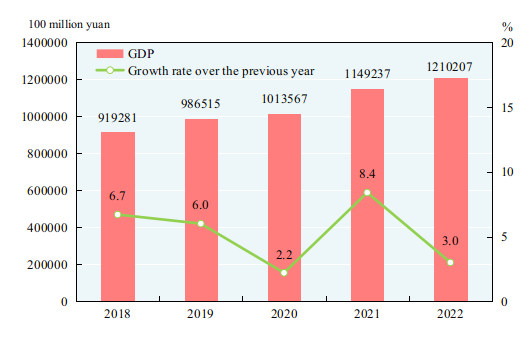
Figure 2: Shares of the Three Industries’ Value Added in GDP 2018-2022

Figure 3: The Overall Labor Productivity 2018-2022[5]
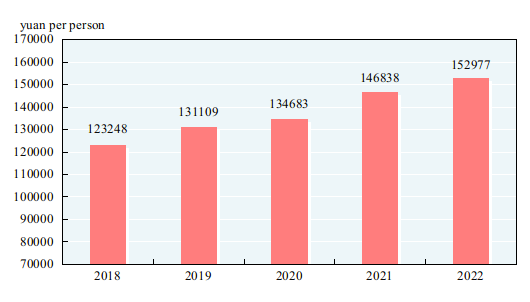
By the end of 2022, the total number of national population[6] reached 1,411.75 million, a decrease of 0.85 million over that at the end of 2021. Of this total, urban permanent residents numbered 920.71 million. There were 9.56 million births in 2022 with a crude birth rate of 6.77 per thousand; and there were 10.41 million deaths with a crude death rate of 7.37 per thousand. The natural growth rate was -0.60 per thousand.
Table 1: Population and Its Composition by the End of 2022
|
Item |
Population at Year-end (10,000 persons) |
Proportion (%) |
|
|
|
|
|
National Total |
141175 |
100.0 |
|
Of which: Urban |
92071 |
65.2 |
|
Rural |
49104 |
34.8 |
|
Of which: Male |
72206 |
51.1 |
|
Female |
68969 |
48.9 |
|
Of which: Aged 0-15 (under the age of 16)[7] |
25615 |
18.1 |
|
Aged 16-59 (under the age of 60) |
87556 |
62.0 |
|
Aged 60 and above |
28004 |
19.8 |
|
Of which: Aged 65 and above |
20978 |
14.9 |
|
|
|
|
At the end of 2022, the number of employed people in China was 733.51 million, and that in urban areas was 459.31 million, accounting for 62.6 percent of the total employed people. The newly increased employed people in urban areas numbered 12.06 million in 2022, 0.63 million less than that of the previous year. The surveyed urban unemployment rate in 2022 averaged 5.6 percent. The surveyed urban unemployment rate at the year end was 5.5 percent. The total number of migrant workers[8] was 295.62 million, up by 1.1 percent over that of 2021. Specifically, the number of migrant workers who left their hometowns and worked in other places was 171.90 million, up by 0.1 percent, and those who worked in their own localities reached 123.72 million, up by 2.4 percent.
Figure 4:Newly Increased Employed People in Urban Areas 2018-2022
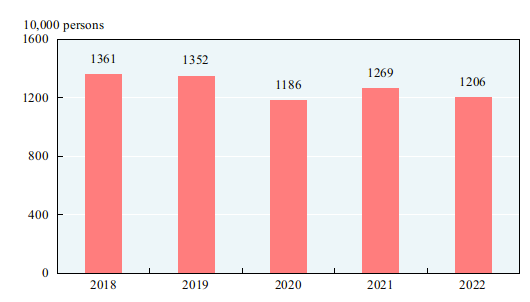
The consumer prices in 2022 went up by 2.0 percent over the previous year. The producer prices for industrial products went up by 4.1 percent and the purchasing prices for industrial producers up by 6.1 percent. The producer prices for farm products[9] grew up by 0.4 percent. In December, out of the 70 large and medium-sized cities, 16 cities experienced a year-on-year rise in sales prices of new commercial residential buildings, one city maintained the same and 53 cities experienced a decline; 6 cities experienced a year-on-year rise in sales prices of second-hand housing, and 64 cities experienced a decline.
Figure 5:Monthly Changes of Consumer Prices in 2022
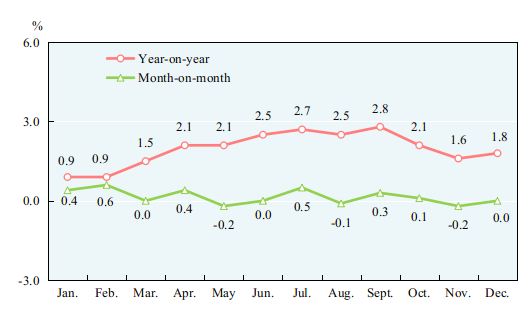
Table 2: Changes of Consumer Prices in 2022
Unit: %
|
Item |
National |
|
|
|
Urban |
Rural |
||
|
|
|
|
|
|
General level of consumer prices |
2.0 |
2.0 |
2.0 |
|
Of which: Food, tobacco and liquor |
2.4 |
2.6 |
2.1 |
|
Clothing |
0.5 |
0.6 |
0.3 |
|
Residence[10] |
0.7 |
0.5 |
1.3 |
|
Household facilities, articles and services |
1.2 |
1.2 |
1.0 |
|
Transportation and telecommunication |
5.2 |
5.2 |
5.0 |
|
Education, culture and recreation |
1.8 |
1.9 |
1.7 |
|
Health care and medical services |
0.6 |
0.6 |
0.8 |
|
Miscellaneous goods and services |
1.6 |
1.5 |
2.0 |
|
|
|
|
|
At the end of 2022, China’s foreign exchange reserves reached 3,127.7 billion US dollars, a decrease of 122.5 billion US dollars compared with that at the end of 2021. The average exchange rate of the year was 6.7261 RMB to 1 USD dollar, depreciated by 4.1 percent over that of 2021.
Figure 6:Year-end China's Foreign Exchange Reserves 2018-2022
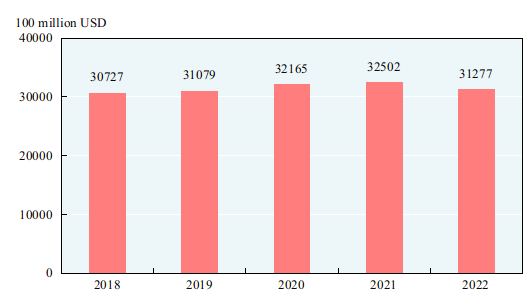
New industries, new forms and models of business grew fast. Among the industries above the designated size, the value added of the high technology manufacturing industry[11] increased by 7.4 percent over the previous year, accounting for 15.5 percent of that of all industrial enterprises above the designated size. The value added for the manufacture of equipment[12] was up by 5.6 percent, accounting for 31.8 percent of that of all industrial enterprises above the designated size. Among the service enterprises above the designated size[13], the business revenue of the strategic emerging service industries[14] went up by 4.8 percent compared with the previous year. In 2022, the investment in high technology industries[15] increased by 18.9 percent over the previous year. In 2022, the output of new energy vehicles reached 7.003 million, up by 90.5 percent over the previous year; and that of solar cells (photovoltaic cells) was 0.34 billion kilowatts, up by 46.8 percent. In 2022, the e-commerce transactions[16] reached 43,829.9 billion yuan, up by 3.5 percent over the previous year on comparable basis. The online retail sales[17] in 2022 reached 13,785.3 billion yuan, up by 4.0 percent over the previous year on comparable basis. In 2022, the number of newly registered market entities was 29.08 million with 0.024 million market entities newly registered per day on average. By the end of 2022, the number of market entities reached nearly 0.17 billion in total.
Steady progress was made in the coordinated development across urban and rural areas and different regions. By the end of 2022, the urbanization rate of permanent residents reached 65.22 percent, 0.50 percentage points higher than that at the end of 2021. By region[18], in 2022, the gross domestic product in the eastern areas was 62,201.8 billion yuan, an increase of 2.5 percent over the previous year; the central areas, 26,651.3 billion yuan, up by 4.0 percent; the western areas, 25,698.5 billion yuan, up by 3.2 percent; and the northeastern areas, 5,794.6 billion yuan, up by 1.3 percent. In 2022, the gross domestic product in Beijing-Tianjin-Hebei Region reached 10,029.3 billion yuan, up by 2.0 percent over the previous year; that in the Yangtze River Economic Belt, 55,976.6 billion yuan, up by 3.0 percent; and that in the Yangtze River Delta, 29,028.9 billion yuan, up by 2.5 percent. Major regional strategies such as the construction of Guangdong-Hong Kong-Macao Greater Bay Areas, and the ecological protection and high-quality development of the Yellow River Basin were further implemented.
Figure 7:Year-end Urbanization Rates of Permanent Residents 2018-2022
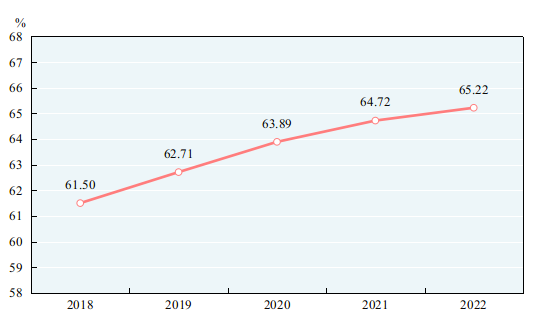
New strides were made in green transformation. The national energy consumption per 10,000 yuan worth of GDP[19] in 2022 dropped by 0.1 percent over the previous year. In 2022, the electricity generated by clean energy such as hydropower, nuclear power, wind power and solar power was 2,959.9 billion kilowatts-hours, up by 8.5 percent over the previous year. Of the monitored 339 cities at prefecture level and above, 62.8 percent reached the air quality standard and 37.2 percent failed. The annual average concentration of particulate matter (PM2.5) was 29 micrograms per cubic meter, down by 3.3 percent over the previous year. Of the 3,641 sections under the national monitoring program for surface water, 87.9 percent were of fairly clean water quality (Grade I to III), 9.7 percent were Grade IV, 1.7 percent were Grade V and 0.7 percent were worse than Grade V national standard.
II. Agriculture
In 2022, the sown area of grain was 118.33 million hectares, an increase of 0.70 million hectares compared with that in 2021. Of this total, the sown area of rice was 29.45 million hectares, a decrease of 0.47 million hectares; the sown area of wheat was 23.52 million hectares, a decrease of 0.05 million hectares; the sown area of corn was 43.07 million hectares, a decrease of 0.25 million hectares; the sown area of soybean was 10.24 million hectares, an increase of 1.83 million hectares. The sown area of cotton was 3.00 million hectares, a decrease of 0.03 million hectares. The sown area of oil-bearing crops was 13.14 million hectares, an increase of 0.04 million hectares; the sown area of sugar crops was 1.47 million hectares, an increase of 0.01 million hectares.
The total output of grain in 2022 was 686.53 million tons, an increase of 3.68 million tons over the previous year, up by 0.5 percent. Of this total, the output of summer crops was 147.40 million tons, up by 1.0 percent, and that of the early rice was 28.12 million tons, up by 0.4 percent. The output of autumn grain was 511.00 million tons, up by 0.4 percent. The output of cereal in 2022 was 633.24 million tons, up by 0.1 percent over 2021, among which the output of rice was 208.49 million tons, down by 2.0 percent; that of wheat was 137.72 million tons, up by 0.6 percent; and that of corn was 277.20 million tons, up by 1.7 percent. The output of soybean was 20.28 million tons, up by 23.7 percent.
Figure 8: Output of Grain 2018-2022
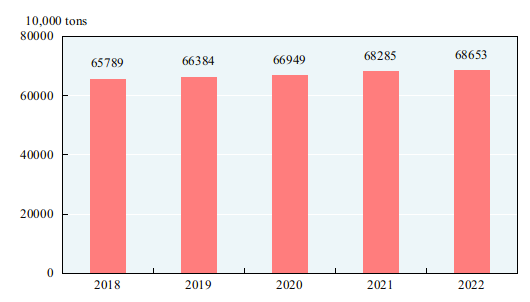
In 2022, the output of cotton was 5.98 million tons, up by 4.3 percent over the previous year, that of oil-bearing crops was 36.53 million tons, up by 1.1 percent, that of sugar crops was 114.44 million tons, down by 0.1 percent, and that of tea was 3.35 million tons, up by 5.7 percent.
The total output of pork, beef, mutton and poultry in 2022 was 92.27 million tons, up by 3.8 percent over the previous year. Of this total, the output of pork was 55.41 million tons, up by 4.6 percent; that of beef was 7.18 million tons, up by 3.0 percent; that of mutton was 5.25 million tons, up by 2.0 percent; and that of poultry was 24.43 million tons, up by 2.6 percent. The total output of eggs was 34.56 million tons, up by 1.4 percent. The output of milk was 39.32 million tons, up by 6.8 percent. At the end of the year, 452.56 million pigs were registered in the total stocks, up by 0.7 percent compared with that at the end of 2021, and 699.95 million pigs were slaughtered, up by 4.3 percent over the previous year.
The total output of aquatic products in 2022 was 68.69 million tons, up by 2.7 percent over the previous year. Of this total, the output of cultured aquatic products was 55.68 million tons, up by 3.2 percent; and that of fished aquatic products was 13.01 million tons, up by 0.4 percent.
The total production of timber in 2022 reached 106.93 million cubic meters, down by 7.7 percent over the previous year.
In 2022, the number of farmland newly equipped with irrigation systems was 0.78 million hectares and 1.61 million hectares of farmland was newly equipped with water-saving irrigation systems.
III. Industry and Construction
In 2022, the total value added of the industrial sector was 40,164.4 billion yuan, up by 3.4 percent over the previous year. The value added of industrial enterprises above the designated size increased by 3.6 percent. Of the industrial enterprises above the designated size, in terms of ownership, the value added of the state-holding enterprises was up by 3.3 percent, that of the share-holding enterprises up by 4.8 percent, that of the enterprises funded by foreign investors and investors from Hong Kong, Macao and Taiwan down by 1.0 percent and that of private enterprises up by 2.9 percent. In terms of sectors, the value added of the mining industry was up by 7.3 percent, that of manufacturing up by 3.0 percent and that of production and supply of electricity, heat power, gas and water up by 5.0 percent.
Figure 9: Value Added and Growth Rates of Industrial Enterprises 2018-2022

In 2022, of the industrial enterprises above the designated size, the value added for processing of food from agricultural and sideline products was up by 0.7 percent over the previous year; for textile industry down by 2.7 percent; for manufacture of raw chemical materials and chemical products up by 6.6 percent; for manufacture of non-metallic mineral products down by 1.5 percent; for smelting and pressing of ferrous metals up by 1.2 percent; for manufacture of general purpose machinery down by 1.2 percent; for manufacture of special purpose machinery up by 3.6 percent; for manufacture of automobiles up by 6.3 percent; for manufacture of electrical machinery and apparatus up by 11.9 percent; for manufacture of computers, communication equipment and other electronic equipment up by 7.6 percent; for production and supply of electricity and heat power up by 5.1 percent.
Table 3: Output of Major Industrial Products and Growth Rates in 2022[20]
|
Product |
Unit |
Output |
Increase over 2021 (%) |
|
|
|
|
|
|
Yarn |
10000 tons |
2719.1 |
-5.4 |
|
Cloth |
100 million meters |
467.5 |
-6.9 |
|
Chemical fiber |
10000 tons |
6697.8 |
-0.2 |
|
Refined sugar (final product) |
10000 tons |
1486.8 |
2.6 |
|
Cigarettes |
100 million |
24321.5 |
0.6 |
|
Color TV sets |
10000 |
19578.3 |
5.8 |
|
Household refrigerators |
10000 |
8664.4 |
-3.6 |
|
Air conditioners |
10000 |
22247.3 |
1.9 |
|
Primary energy output |
100 million tons of standard coal equivalent |
46.6 |
9.2 |
|
Coal |
100 million tons |
45.6 |
10.5 |
|
Crude petroleum oil |
10000 tons |
20472.2 |
2.9 |
|
Natural gas |
100 million cubic meters |
2201.1 |
6.0 |
|
Electricity |
100 million kilowatt-hours |
88487.1 |
3.7 |
|
Of which: Thermal power[21] |
100 million kilowatt-hours |
58887.9 |
1.4 |
|
Hydropower |
100 million kilowatt-hours |
13522.0 |
1.0 |
|
Nuclear-power |
100 million kilowatt-hours |
4177.8 |
2.5 |
|
Wind power |
100 million kilowatt-hours |
7626.7 |
16.2 |
|
Solar power |
100 million kilowatt-hours |
4272.7 |
31.2 |
|
Crude steel |
10000 tons |
101795.9 |
-1.7 |
|
Rolled steel[22] |
10000 tons |
134033.5 |
0.3 |
|
Ten kinds of nonferrous metals |
10000 tons |
6793.6 |
4.9 |
|
Of which: Refined copper (copper) |
10000 tons |
1106.3 |
5.5 |
|
Aluminum electrolyze |
10000 tons |
4021.4 |
4.4 |
|
Cement |
100 million tons |
21.3 |
-10.5 |
|
Sulfuric acid (100%) |
10000 tons |
9504.6 |
1.3 |
|
Caustic soda (100%) |
10000 tons |
3980.5 |
2.3 |
|
Ethylene |
10000 tons |
2897.5 |
2.5 |
|
Chemical fertilizers(100 percent equivalent) |
10000 tons |
5573.3 |
0.5 |
|
Power generation equipment |
10000 kilowatts |
18376.1 |
15.0 |
|
Motor vehicles |
10000 |
2718.0 |
3.5 |
|
Of which: New energy vehicles |
10000 |
700.3 |
90.5 |
|
Large and medium tractors |
10000 |
40.0 |
-2.8 |
|
Integrated circuits |
100 million pieces |
3241.9 |
-9.8 |
|
Program-controlled switchboards |
10000 lines |
883.8 |
26.3 |
|
Mobile telephones |
10000 |
156080.0 |
-6.1 |
|
Micro computer equipment |
10000 |
43418.2 |
-7.0 |
|
Industrial robots |
10000 sets |
44.3 |
21.0 |
|
Solar cells(photovoltaic cells) |
10000 kilowatt |
34364.2 |
46.8 |
|
Charging piles |
10000 |
191.5 |
80.3 |
|
|
|
|
|
By the end of 2022, the installed power generation capacity was 2,564.05 million kilowatts, up by 7.8 percent over that at the end of 2021, among which[23] the installed thermal power generation capacity was 1,332.39 million kilowatts, up by 2.7 percent; the installed hydropower generation capacity was 413.50 million kilowatts, up by 5.8 percent; the installed nuclear power generation capacity was 55.53 million kilowatts, up by 4.3 percent. The installed grid-connected wind power generation capacity was 365.44 million kilowatts, up by 11.2 percent and the installed grid-connected solar power generation capacity was 392.61 million kilowatts, up by 28.1 percent.
In 2022, the profits made by industrial enterprises above the designated size were 8,403.9 billion yuan, down by 4.0 percent over the previous year[24]. By ownership, the profits of state-holding enterprises were 2,379.2 billion yuan, up by 3.0 percent over the previous year; those of share-holding enterprises were 6,161.1 billion yuan, down by 2.7 percent; those of enterprises funded by foreign investors or investors from Hong Kong, Macao and Taiwan were 2,004.0 billion yuan, down by 9.5 percent; and those of private enterprises were 2,663.8 billion yuan, down by 7.2 percent. In terms of different sectors, the profits of mining were 1,557.4 billion yuan, up by 48.6 percent over the previous year; those of manufacturing were 6,415.0 billion yuan, down by 13.4 percent; and those of the production and supply of electricity, heat power, gas and water were 431.5 billion yuan, up by 41.8 percent. In 2022, the cost for per-hundred-yuan business revenue of the industrial enterprises above the designated size was 84.72 yuan, or 0.91 yuan more than that of 2021; the profit rate of the business revenue was 6.09 percent, down by 0.64 percentage points. By the end of 2022, the asset-liability ratio of industrial enterprises above the designated size was 56.6 percent, 0.3 percentage points higher than that at the end of 2021. The national industrial capacity utilization rate[25] was 75.6 percent in 2022.
In 2022, the value added of construction enterprises in China was 8,338.3 billion yuan, up by 5.5 percent over the previous year. The profits made by construction enterprises qualified for general contracts and specialized contracts reached 836.9 billion yuan, down by 1.2 percent over the previous year, of which the profits made by state-holding enterprises were 392.2 billion yuan, up by 8.4 percent.
Figure 10: Value Added and Growth Rates of Construction Industry 2018-2022
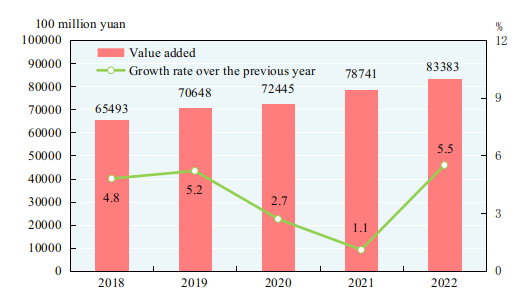
IV. Service Sector
In 2022, the value added of the wholesale and retail trades was 11,451.8 billion yuan, up by 0.9 percent over the previous year; that of transport, storage and post was 4,967.4 billion yuan, down by 0.8 percent; that of hotels and catering services was 1,785.5 billion yuan, down by 2.3 percent; that of financial intermediation was 9,681.1 billion yuan, up by 5.6 percent; that of real estate was 7,382.1 billion yuan, down by 5.1 percent; that of information transmission, software and information technology services was 4,793.4 billion yuan, up by 9.1 percent; and that of leasing and business services was 3,915.3 billion yuan, up by 3.4 percent. In 2022, the business revenue of service enterprises above the designated size grew by 2.7 percent over the previous year, and the total profit increased by 8.5 percent.
Figure 11: Value Added and Growth Rates of Service Sector 2018-2022

The total freight traffic[26] in 2022 reached 51.5billion tons. The freight flows were 23,174.4 billion ton-kilometers. The volume of freight handled by ports throughout the year totaled 15.7 billion tons, up by 0.9 percent over the previous year, of which the freight for foreign trade was 4.6 billion tons, down by 1.9 percent. Container shipping of ports reached 295.87 million standard containers, up by 4.7 percent.
Table 4: Freight Traffic by All Means of Transportation and Growth Rates in 2022
|
Item |
Unit |
Volume |
Increase over 2021(%) |
|
|
|
|
|
|
Total freight traffic |
100 million tons |
514.7 |
-3.0 |
|
Railways |
100 million tons |
49.3 |
4.5 |
|
Highways |
100 million tons |
371.2 |
-5.5 |
|
Waterways |
100 million tons |
85.5 |
3.8 |
|
Civil aviation |
10000 tons |
607.6 |
-17.0 |
|
Pipelines |
100 million tons |
8.6 |
3.1 |
|
Freight flows |
100 million ton-kilometers |
231743.5 |
3.4 |
|
Railways |
100 million ton-kilometers |
35906.5 |
8.2 |
|
Highways |
100 million ton-kilometers |
68958.0 |
-1.2 |
|
Waterways |
100 million ton-kilometers |
121003.1 |
4.7 |
|
Civil aviation |
100 million ton-kilometers |
254.1 |
-8.7 |
|
Pipelines |
100 million ton-kilometers |
5621.8 |
3.7 |
|
|
|
|
|
In 2022, the total passenger traffic was 5.6 billion person-times, down by 32.7 percent over 2021, and the passenger flows were 1,292.1 billion person-kilometers, down by 34.6 percent.
Table 5: Passenger Traffic by All Means of Transportation and Growth Rates in 2022
|
Item |
Unit |
Volume |
Increase over 2021(%) |
|
|
|
|
|
|
Total passenger traffic |
100 million person-times |
55.9 |
-32.7 |
|
Railways |
100 million person-times |
16.7 |
-35.9 |
|
Highways |
100 million person-times |
35.5 |
-30.3 |
|
Waterways |
100 million person-times |
1.2 |
-28.8 |
|
Civil aviation |
100 million person-times |
2.5 |
-42.9 |
|
Passenger flows |
100 million person-kilometers |
12921.4 |
-34.6 |
|
Railways |
100 million person-kilometers |
6577.5 |
-31.3 |
|
Highways |
100 million person-kilometers |
2407.5 |
-33.7 |
|
Waterways |
100 million person-kilometers |
22.6 |
-31.7 |
|
Civil aviation |
100 million person-kilometers |
3913.7 |
-40.1 |
|
|
|
|
|
The total number of motor vehicles for civilian use reached 319.03 million (including 7.19 million tri-wheel motor vehicles and low-speed trucks) by the end of 2022, up by 17.52 million over that at the end of 2021, of which the privately-owned vehicles numbered 278.73 million, an increase of 16.27 million. The total number of cars for civilian use was 177.40 million, an increase of 10.03 million, of which the privately-owned cars numbered 166.85 million, an increase of 9.54 million.
The turnover of post services[27] totaled 1,431.7 billion yuan, up by 4.5 percent over the previous year. In 2022, the number of mail delivery was 0.94 billion; that of parcel delivery was 0.02 billion; and that of express delivery was 110.58 billion with a revenue reaching 1,056.7 billion yuan. The turnover of telecommunication services[28] totaled 1,749.8 billion yuan, up by 21.3 percent over the previous year. By the end of 2022, there were 10.83 million mobile phone base stations[29], among which the number of 4G base stations reached 6.03 million and that of 5G base stations was 2.31 million. There were 1,862.86 million phone subscribers in China, of whom 1,683.44 million were mobile phone subscribers. The mobile phone coverage was 119.2 sets per 100 persons. The number of fixed broadband internet users[30] reached 589.65 million, an increase of 53.86 million over that at the end of the previous year. Of this total, users of broadband with the speed of 100M and above[31] amounted to 553.80 million, an increase of 55.13 million. Users of cellular internet of things terminals[32] totaled 1.845 billion, an increase of 0.447 billion. The number of internet users was 1.067 billion, 1.065 billion of which were mobile internet surfers[33]. The coverage of internet was 75.6 percent, and 61.9 percent in rural areas. The mobile internet traffic in 2022 was 261.8 billion gigabytes, up by 18.1 percent over the previous year. Software revenue of software and information technology services industry[34] in 2022 was 10,812.6 billion yuan, up by 11.2 percent over 2021 on a comparable basis.
Figure 12: Express Delivery and Growth Rates 2018-2022
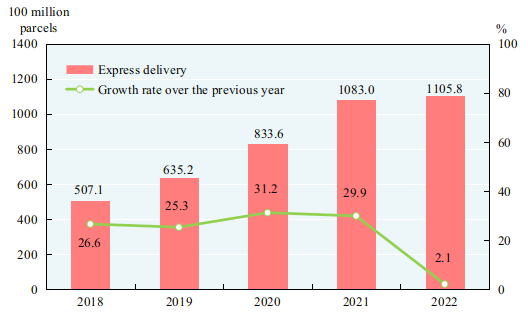
Figure 13: Year-end Number of Fixed Broadband Internet Users 2018-2022
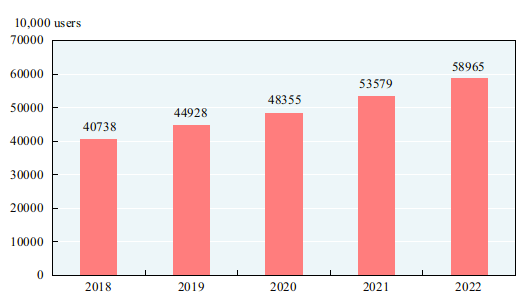
V. Domestic Trade
In 2022, the total retail sales of consumer goods reached 43,973.3 billion yuan, down by 0.2 percent over the previous year. An analysis on different areas showed that the retail sales of consumer goods in urban areas stood at 38,044.8 billion yuan, down by 0.3 percent, and that in rural areas reached 5,928.5 billion yuan, maintaining the same level as the previous year. Grouped by consumption patterns, the retail sales of commodities were 39,579.2 billion yuan, up by 0.5 percent, and the income of catering industry was 4,394.1 billion yuan, down by 6.3 percent.
Figure 14: Total Retail Sales of Consumer Goods and Growth Rates 2018-2022
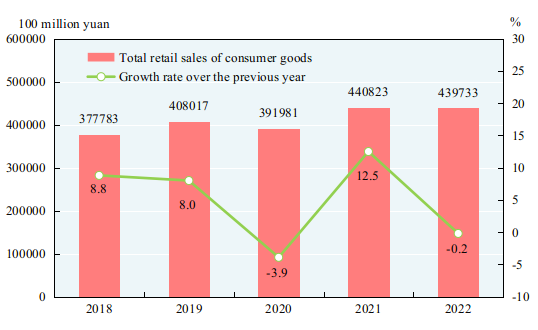
Of the total retail sales of commodities by enterprises above the designated size, the retail sales for grain, oil and food went up by 8.7 percent over the previous year; beverage up by 5.3 percent; tobacco and liquor up by 2.3 percent; clothes, shoes, hats and textiles down by 6.5 percent; cosmetics down by 4.5 percent; gold, silver and jewelry down by 1.1 percent; daily necessities down by 0.7 percent; household appliances and audio-video equipment down by 3.9 percent; traditional Chinese and western medicines up by 12.4 percent; cultural and office appliances up by 4.4 percent; furniture down by 7.5 percent; telecommunication equipment down by 3.4 percent; petroleum and petroleum products up by 9.7 percent; motor vehicles up by 0.7 percent; and building and decoration materials down by 6.2 percent.
In 2022, the online retail sales of physical goods were 11,964.2 billion yuan, up by 6.2 percent over the previous year on a comparable basis, accounting for 27.2 percent of the total retail sales of consumer goods.
VI. Investment in Fixed Assets
The total investment in fixed assets of the country in 2022 was 57,955.6 billion yuan, up by 4.9 percent over the previous year. The investment in fixed assets (excluding rural households) was 57,213.8 billion yuan, up by 5.1 percent. Of the investment in fixed assets (excluding rural households), by regions[35], the investment in eastern areas was up by 3.6 percent, central areas up by 8.9 percent, western areas up by 4.7 percent, and northeastern areas up by 1.2 percent.
Of the investment in fixed assets (excluding rural households), the investment in the primary industry was 1,429.3 billion yuan, up by 0.2 percent over the previous year; that in the secondary industry was 18,400.4 billion yuan, up by 10.3 percent; and that in the tertiary industry was 37,384.2 billion yuan, up by 3.0 percent. The private investment in fixed assets[36] was 31,014.5 billion yuan, up by 0.9 percent. The investment in infrastructure[37] increased by 9.4 percent. The investment in social sector[38] increased by 10.9 percent.
Figure 15: Shares of Investment in Fixed Assets (Excluding Rural Households) of the Three Industries in 2022

Table 6: Growth Rates of Investment in Fixed Assets (Excluding Rural Households) by Sectors in 2022
|
Sector |
Increase over 2021 (%) |
Sector |
Increase over 2021 (%) |
|
|
|
|
|
|
Total |
5.1 |
Financial Intermediation |
10.5 |
|
Agriculture, Forestry, Animal Husbandry and Fishery |
4.2 |
Real Estate[39] |
-8.4 |
|
Mining |
4.5 |
Leasing and Business Services |
14.5 |
|
Manufacturing |
9.1 |
Scientific Research and Technical Services |
21.0 |
|
Production and Supply of Electricity, Heat Power, Gas and Water |
19.3 |
Water Conservancy, Environment and Public Facilities Management |
10.3 |
|
Construction |
2.0 |
Services to Households, Repair and Other Services |
21.8 |
|
Wholesale and Retail Trades |
5.3 |
Education |
5.4 |
|
Transport, Storage and Post |
9.1 |
Health and Social Service |
26.1 |
|
Hotels and Catering Services |
7.5 |
Culture, Sports and Entertainment |
3.5 |
|
Information Transmission, Software and Information Technology Services |
21.8 |
Public Management, Social Security and Social Organizations |
42.1 |
|
|
|
|
|
Table 7: Newly Increased Production and Operation Capacity through Fixed Assets Investment in 2022
|
Item |
Unit |
Volume |
|
|
|
|
|
Newly increased power transformer equipment with a capacity of over 220 kilovolts |
10,000 kilovolt-amperes |
25839 |
|
New railways put into operation |
kilometer |
4100 |
|
Of which: high-speed railways |
kilometer |
2082 |
|
Extended or new double-track railways put into operation |
kilometer |
2658 |
|
Electrified railways put into operation |
kilometer |
3452 |
|
Length of new and rebuilt highways |
kilometer |
8771 |
|
New throughput capacity of berths for over 10,000-tonnage ships |
10,000 tons/year |
25561 |
|
New civil transportation airports |
- |
6 |
|
New lines of optical-fiber cables |
10,000 km |
477 |
|
|
|
|
In 2022, the investment in real estate development was 13,289.5 billion yuan, down by 10.0 percent over the previous year. Of this total, the investment in residential buildings reached 10,064.6 billion yuan, a decrease of 9.5 percent, that in office buildings was 529.1 billion yuan, down by 11.4 percent, and that in buildings for commercial business was 1,064.7 billion yuan, down by 14.4 percent. The floor space of the commercial buildings for sale was 563.66 million square meters at the end of 2022, an increase of 53.43 million square meters over that at the end of 2021. The floor space of the commercial residential buildings for sale was 269.47 million square meters, an increase of 41.86 million square meters.
In 2022, 1.34 million housing units were started to be rebuilt in rundown urban areas nationwide and 1.81 million were basically completed. There were 2.65 million units of government-subsidized rental housing that were started to be built or made available. Renovation began on 52,500 old urban residential communities, benefiting 8.76 million households.
Table 8: Main Indicators for Real Estate Development and Sales and Growth Rates in 2022
|
Item |
Unit |
Volume |
Increase over 2021 (%) |
|
|
|
|
|
|
Value of Investment |
100 million RMB |
132895 |
-10.0 |
|
Of which: residential buildings |
100 million RMB |
100646 |
-9.5 |
|
Floor space of buildings under construction |
10000 square meters |
904999 |
-7.2 |
|
Of which: residential buildings |
10000 square meters |
639696 |
-7.3 |
|
Floor space of buildings newly started |
10000 square meters |
120587 |
-39.4 |
|
Of which: residential buildings |
10000 square meters |
88135 |
-39.8 |
|
Floor space of buildings completed |
10000 square meters |
86222 |
-15.0 |
|
Of which: residential buildings |
10000 square meters |
62539 |
-14.3 |
|
Floor space of commercial buildings sold |
10000 square meters |
135837 |
-24.3 |
|
Of which: residential buildings |
10000 square meters |
114631 |
-26.8 |
|
Funds for investment this year |
100 million RMB |
148979 |
-25.9 |
|
Of which: domestic loans |
100 million RMB |
17388 |
-25.4 |
|
individual mortgage |
100 million RMB |
23815 |
-26.5 |
|
|
|
|
|
VII. Foreign Economic Relations
The total value of imports and exports of goods in 2022 reached 42,067.8 billion yuan, up by 7.7 percent over that of the previous year. Of this total, the value of goods exported was 23,965.4 billion yuan, up by 10.5 percent; the value of goods imported was 18,102.4 billion yuan, up by 4.3 percent. The surplus of trade in goods reached 5,863.0 billion yuan, up by 1,533.0 billion yuan over that of the previous year. The total value of imports and exports between China and countries along the Belt and Road[40] was 13,833.9 billion yuan, an increase of 19.4 percent over that of the previous year. Of this total, the value of goods exported was 7,887.7 billion yuan, up by 20.0 percent; the value of goods imported was 5,946.1 billion yuan, up by 18.7 percent. The total value of imports and exports between China and other Regional Comprehensive Economic Partnership (RCEP) member countries[41] was 12,949.9 billion yuan, up by 7.5 percent over that of the previous year.
Figure 16: Total Value of Imports and Exports of Goods 2018-2022

Table 9: Total Value and Growth Rates of Imports and Exports of Goods in 2022
|
Item |
Value (100 million yuan) |
Increase over 2021 (%) |
|
|
|
|
|
Total value of import and export of goods |
420678 |
7.7 |
|
Exports |
239654 |
10.5 |
|
Of which: General trade |
152468 |
15.4 |
|
Processing trade |
53952 |
1.1 |
|
Of which: Mechanical and electronic products |
136973 |
7.0 |
|
High & new technology products |
63391 |
0.3 |
|
Imports |
181024 |
4.3 |
|
Of which: General trade |
115624 |
6.7 |
|
Processing trade |
30574 |
-3.2 |
|
Of which: Mechanical and electronic products |
69661 |
-5.4 |
|
High & new technology products |
50864 |
-6.0 |
|
Trade surplus |
58630 |
35.4 |
|
|
|
|
Table 10: Main Export Commodities in Volume and Value and the Growth Rates in 2022
|
Item |
Unit |
Volume |
Increase over 2021 (%) |
Value (100 million yuan) |
Increase over 2021 (%) |
|
|
|
|
|
|
|
|
Rolled steel |
10000 tons |
6732 |
0.9 |
6427 |
22.3 |
|
Textile yarns and textile articles |
— |
— |
— |
9836 |
4.9 |
|
Clothes and clothing accessories |
— |
— |
— |
11713 |
6.7 |
|
Footwear |
10000 pairs |
929318 |
6.6 |
3844 |
24.4 |
|
Furniture and parts |
— |
— |
— |
4639 |
-2.5 |
|
Luggage and similar containers |
10000 tons |
297 |
22.2 |
2378 |
32.6 |
|
Toys |
— |
— |
— |
3229 |
9.1 |
|
Plastic articles |
— |
— |
— |
7188 |
12.7 |
|
Integrated circuits |
100 million pieces |
2734 |
-12.0 |
10254 |
3.5 |
|
Automatic data processing machines and components |
— |
— |
— |
15701 |
-4.7 |
|
Mobile phones |
10000 sets |
82224 |
-13.8 |
9527 |
0.9 |
|
Containers |
10000 units |
321 |
-33.7 |
967 |
-36.1 |
|
Liquid crystal display panels |
10000 units |
164560 |
— |
1807 |
— |
|
Motor vehicles (including chassis) |
10000 sets |
332 |
56.8 |
4054 |
82.2 |
|
|
|
|
|
|
|
Table 11: Main Import Commodities in Volume and Value and the Growth Rates in 2022
|
Item |
Unit |
Volume |
Increase over 2021 (%) |
Value (100 million yuan) |
Increase over 2021 (%) |
|
|
|
|
|
|
|
|
Soybean |
10000 tons |
9108 |
-5.6 |
4085 |
18.1 |
|
Edible vegetable oil |
10000 tons |
648 |
-37.6 |
606 |
-14.1 |
|
Iron ore and concentrate |
10000 tons |
110686 |
-1.5 |
8498 |
-27.9 |
|
Coal and lignite |
10000 tons |
29320 |
-9.2 |
2855 |
22.2 |
|
Crude oil |
10000 tons |
50828 |
-0.9 |
24350 |
45.9 |
|
Petroleum products refined |
10000 tons |
2645 |
-2.5 |
1309 |
21.2 |
|
Natural gas |
10000 tons |
10925 |
-9.9 |
4683 |
30.3 |
|
Plastics in primary forms |
10000 tons |
3058 |
-10.0 |
3734 |
-5.5 |
|
Paper pulp |
10000 tons |
2916 |
-1.8 |
1492 |
15.1 |
|
Rolled steel |
10000 tons |
1057 |
-25.9 |
1136 |
-6.1 |
|
Unwrought copper and its alloys |
10000 tons |
587 |
6.2 |
3610 |
6.5 |
|
Integrated circuits |
100 million pieces |
5384 |
-15.3 |
27663 |
-0.9 |
|
Motor vehicles (including chassis) |
10000 sets |
88 |
-6.5 |
3529 |
1.2 |
|
|
|
|
|
|
|
Table 12: Imports and Exports of Goods by Major Countries and Regions, the Growth Rates and Proportions in 2022
|
Country or region |
Exports (100 million yuan) |
Increase over 2021 (%) |
Proportion of the total (%) |
Imports (100 million yuan) |
Increase over 2021 (%) |
Proportion of the total (%) |
|
|
|
|
|
|
|
|
|
ASEAN |
37907 |
21.7 |
15.8 |
27247 |
6.8 |
15.1 |
|
European Union |
37434 |
11.9 |
15.6 |
19034 |
-4.9 |
10.5 |
|
United States |
38706 |
4.2 |
16.2 |
11834 |
1.9 |
6.5 |
|
Republic of Korea |
10843 |
13.0 |
4.5 |
13278 |
-3.7 |
7.3 |
|
Japan |
11537 |
7.7 |
4.8 |
12295 |
-7.5 |
6.8 |
|
Taiwan, China |
5423 |
7.2 |
2.3 |
15840 |
-1.8 |
8.8 |
|
Hong Kong, China |
19883 |
-12.0 |
8.3 |
527 |
-16.0 |
0.3 |
|
Russia |
5123 |
17.5 |
2.1 |
7638 |
48.6 |
4.2 |
|
Brazil |
4128 |
19.3 |
1.7 |
7294 |
2.6 |
4.0 |
|
India |
7896 |
25.5 |
3.3 |
1160 |
-36.2 |
0.6 |
|
South Africa |
1615 |
18.6 |
0.7 |
2173 |
2.0 |
1.2 |
|
|
|
|
|
|
|
|
The total value of imports and exports of services in 2022 was 5,980.2 billion yuan, up by 12.9 percent over that of the previous year. The export value of services was 2,852.2 billion yuan, up by 12.1 percent. The import value of services was 3,127.9 billion yuan, up by 13.5 percent. The trade deficit in imports and exports of services was 275.7 billion yuan.
The year 2022 witnessed the establishment of 38,497 enterprises with foreign direct investment[42], down by 19.2 percent over that of the previous year, and the foreign direct investment actually utilized totaled 1,232.7 billion yuan, up by 6.3 percent, or 189.1 billion US dollars, up by 8.0 percent. Specifically, there were 4,519 newly established enterprises receiving direct investment from countries along the Belt and Road (including the investment in China via some free ports), down by 15.3 percent; and foreign capital directly invested in China reached 89.1 billion yuan, up by 17.2 percent, or 13.7 billion US dollars, up by 18.6 percent. In 2022, the foreign investment actually utilized by high technology industry reached 444.9 billion yuan, up by 28.3 percent, or 68.3 billion US dollars, up by 30.9 percent.
Table 13: Total Value of Foreign Direct Investment and the Growth Rates in 2022
|
Sector |
Enterprises |
Increase over 2021 (%) |
Actually Utilized Value (100 million yuan) |
Increase over 2021 (%) |
|
|
|
|
|
|
|
Total |
38497 |
-19.2 |
12327 |
6.3 |
|
Of which: Agriculture, Forestry, Animal Husbandry and Fishery |
420 |
-14.5 |
80 |
44.6 |
|
Manufacturing |
3570 |
-19.9 |
3237 |
46.1 |
|
Production and Supply of Electricity, Heat Power, Gas and Water |
523 |
12.5 |
276 |
10.8 |
|
Transport, Storage and Post |
602 |
-13.1 |
347 |
-1.1 |
|
Information Transmission, Software and Information Technology Services |
3059 |
-24.5 |
1548 |
15.1 |
|
Wholesale and Retail |
10894 |
-18.6 |
961 |
-12.5 |
|
Real Estate |
581 |
-48.4 |
914 |
-41.8 |
|
Leasing and Business Services |
7473 |
-19.6 |
2148 |
-2.1 |
|
Services to Households, Repair and Other Services |
411 |
-21.3 |
19 |
-38.6 |
|
|
|
|
|
|
In 2022, the non-financial outbound direct investment reached 785.9 billion yuan, up by 7.2 percent over that of the previous year, or 116.9 billion US dollars, up by 2.8 percent. Of this total, that to countries along the Belt and Road reached 141.0 billion yuan, up by 7.7 percent, or 21.0 billion US dollars, up by 3.3 percent.
Table 14: Total Value and Growth Rates of Non-financial Outbound Direct Investment in 2022
|
Sector |
Value (100 million US dollars) |
Increase over 2021 (%) |
|
|
|
|
|
Total |
1168.5 |
2.8 |
|
Of which: Agriculture, Forestry, Animal Husbandry and Fishery |
8.3 |
-26.5 |
|
Mining |
50.1 |
0.6 |
|
Manufacturing |
216.0 |
17.4 |
|
Production and Supply of Electricity, Heat Power, Gas and Water |
35.2 |
-28.0 |
|
Construction |
64.0 |
14.9 |
|
Wholesale and Retail |
211.0 |
19.5 |
|
Transport, Storage and Post |
45.6 |
-10.6 |
|
Information Transmission, Software and Information Technology Services |
54.9 |
-27.1 |
|
Real Estate |
24.2 |
-2.8 |
|
Leasing and Business Services |
387.6 |
5.8 |
|
|
|
|
In 2022, the accomplished business revenue through contracted overseas engineering projects was 1,042.5 billion yuan, up by 4.3 percent over that of the previous year, or 155.0 billion US dollars, basically the same as that of the previous year. Specifically, the accomplished business revenue from countries along the Belt and Road was 84.9 billion US dollars, a decrease of 5.3 percent, accounting for 54.8 percent of the accomplished business revenue through contracted overseas engineering projects. The number of labor forces sent abroad through overseas labor contracts was 260 thousand.
VIII. Finance and Financial Intermediation
The national general public budget revenue reached 20,370.3 billion yuan in 2022, up by 0.6 percent over that of the previous year, of which tax revenue amounted to 16,661.4 billion yuan, down by 3.5 percent. The national general public budget expenditure reached 26,060.9 billion yuan, up by 6.1 percent over that of the previous year. The newly added tax refunds, as well as tax and fee cuts and deferrals exceeded 4.2 trillion yuan in 2022. Specifically, the value-added tax credits refunded to taxpayers’ accounts reached 2.46 trillion yuan, new tax and fee cuts exceeded 1 trillion yuan and tax and fee deferrals exceeded 750.0 billion yuan.
Figure 17: National General Public Budget Revenue 2018-2022
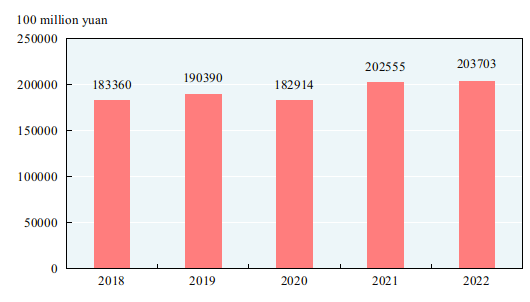
Note: Data for general public budget revenue from 2018 to 2021 as shown in the figure were final accounts and that of 2022 was the executive accounts.
By the end of 2022, money supply of broad sense (M2) was 266.4 trillion yuan, an increase of 11.8 percent over that by the end of the previous year. Money supply of narrow sense (M1) was 67.2 trillion yuan, up by 3.7 percent. Cash in circulation (M0) was 10.5 trillion yuan, up by 15.3 percent.
In 2022, the aggregate financing to the real economy (AFRE) (flow)[43] reached 32.0 trillion yuan, or 0.7 trillion yuan more than that in 2021 on a comparable basis. The AFRE (stock)[44] totaled 344.2 trillion yuan at the end of 2022, up by 9.6 percent over that at the end of 2021 on a comparable basis. Specifically, loans granted to the real economy in Renminbi stood at 212.4 trillion yuan, up by 10.9 percent. Savings deposit in Renminbi and foreign currencies in all items of financial institutions totaled 264.4 trillion yuan at the end of 2022, an increase of 25.9 trillion yuan compared with that at the beginning of the year. Of this total, the savings deposit in Renminbi stood at 258.5 trillion yuan, an increase of 26.3 trillion yuan. Loans in Renminbi and foreign currencies in all items of financial institutions reached 219.1 trillion yuan, an increase of 20.6 trillion yuan. Of this total, loans in Renminbi were 214.0 trillion yuan, an increase of 21.3 trillion yuan. Inclusive finance loans in Renminbi[45] reached 32.1 trillion yuan, an increase of 5.6 trillion yuan.
Table 15: Savings Deposit and Loans in RMB and Foreign Currencies in All Financial Institutions and Growth Rates at the End of 2022
|
Item |
Year-end figure (100 million yuan) |
Increase over 2021 (%) |
|
|
|
|
|
Savings deposit |
2644472 |
10.8 |
|
Domestic households |
1212110 |
17.3 |
|
Deposits in RMB |
1203387 |
17.4 |
|
Domestic non-financial enterprises |
779398 |
6.8 |
|
Loans |
2191029 |
10.4 |
|
Domestic short-term loans |
560304 |
7.7 |
|
Domestic medium- and long-term loans |
1427739 |
10.6 |
|
|
|
|
Loans in Renminbi from rural financial institutions (rural credit cooperatives, rural cooperation banks and rural commercial banks) totaled 26,719.5 billion yuan by the end of 2022, an increase of 2,470.2 billion yuan as compared with that at the beginning of the year. Loans in Renminbi for consumption use from all financial institutions totaled 56,036.1 billion yuan, an increase of 1,152.2 billion yuan. Of the total, househlod short-term consumption loans totaled 9,347.3 billion yuan, a decrease of 9.0 billion yuan, and household medium- and long-term consumption loans reached 46,688.8 billion yuan, an increase of 1,161.3 billion yuan.
Funds raised through A-shares issued on Shanghai and Shenzhen Stock Exchanges[46] amounted to 1,510.9 billion yuan in 2022, a decrease of 163.4 billion yuan from the previous year. A total of 341 new A-shares issued on Shanghai and Shenzhen Stock Exchanges raised 570.4 billion yuan worth of capital altogether, up by 35.3 billion yuan over that of the previous year. Of the total, 123 shares from the science and technology innovation board raisd 252.0 billion yuan; refinancing of A-shares on Shanghai and Shenzhen Stock Exchanges (including public newly issued, targeted placement, right issued, preferred stock and exchanged convertible bonds) raised 940.5 billion yuan, a decrease of 198.6 billion yuan over that of the previous year. 83 shares were publicly issued on Beijing Stock Exchanges, raising[47] 16.4 billion yuan. Various types of market entities financed 6,449.4 billion yuan through issuing bonds (including corporate bonds, asset-backed securities, national and local government bonds and policy bank bonds) on Shanghai, Shenzhen and Beijing Stock Exchanges. Specifically, 13 infrastructure Real Estate Investment Trust Fund (REITs) projects were issued and listed on Shanghai Stock Exchange and Shenzhen Stock Exchange, raising 41.9 billion yuan. There were 6,580 companies listed on National Equities Exchange and Quotations[48] and funds raised by listed companies reached 23.2 billion yuan in 2022.
In 2022, the issuance of corporate credit bonds[49] reached 13.7 trillion yuan, a decrease of 1.0 trillion yuan over that of the previous year.
The premium of primary insurance received by the insurance companies[50] totaled 4,695.7 billion yuan in 2022, up by 4.6 percent over that of the previous year on a comparable basis. Of this total, life insurance premium of primary insurance amounted to 2,451.9 billion yuan, health and casualty insurance premium of primary insurance 972.6 billion yuan, and property insurance premium of primary insurance 1,271.2 billion yuan. Insurance companies paid an indemnity worth of 1,548.5 billion yuan, of which life insurance indemnity was 379.1 billion yuan, health and casualty insurance indemnity 393.7 billion yuan, and property insurance indemnity 775.7 billion yuan.
IX. Households Income and Consumption and Social Security
In 2022, the per capita disposable income nationwide was 36,883 yuan, an increase of 5.0 percent over that of the previous year or a real increase of 2.9 percent after deducting price factors. The median[51] of per capita disposable income nationwide was 31,370 yuan, up by 4.7 percent. In terms of usual residence, the per capita disposable income of urban households was 49,283 yuan, up by 3.9 percent over that of 2021, or a real growth of 1.9 percent after deducting price factors. The median of per capita disposable income of urban households was 45,123 yuan, up by 3.7 percent. The per capita disposable income of rural households was 20,133 yuan, up by 6.3 percent over that of the previous year, or 4.2 percent in real terms after deducting price factors. The median of per capita disposable income of rural households was 17,734 yuan, up by 4.9 percent. The urban-rural per capita disposable income ratio was 2.45, narrowed by 0.05 over that of the previous year. Grouped by income quintile[52] the per capita disposable income of low-income group reached 8,601 yuan, the lower-middle-income group 19,303 yuan, the middle-income group 30,598 yuan, the upper-middle-income group 47,397 yuan and the high-income group 90,116 yuan. The per capita monthly income of migrant workers was 4,615 yuan, increased by 4.1 percent over that of the previous year. In 2022, the per capita disposable income of rural households from counties lifted out of poverty[53] was 15,111 yuan, up by 7.5 percent over that of 2021, or a real growth of 5.4 percent after deducting price factors.
The national per capita consumption expenditure was 24,538 yuan, up by 1.8 percent over that of the previous year, or a real decrease of 0.2 percent after deducting price factors. Specifically, the per capita consumption expenditure on services[54] totaled 10,590 yuan, down by 0.5 percent over that of the previous year, accounting for 43.2 percent of the per capita consumption expenditure. In terms of usual residence, the per capita consumption expenditure of urban households was 30,391 yuan, up by 0.3 percent, or down by 1.7 percent in real terms after deducting price factors. The per capita consumption expenditure of rural households was 16,632 yuan, up by 4.5 percent, or a real increase of 2.5 percent after deducting price factors. The national Engel’s Coefficient stood at 30.5 percent, with that of urban and rural households standing at 29.5 percent and 33.0 percent respectively.
Figure 18: National Per Capita Disposable Income and Its Growth Rates 2018-2022
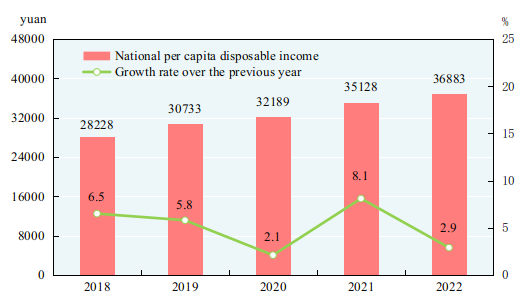
Figure 19: National Per Capita Consumption Expenditure and Composition in 2022
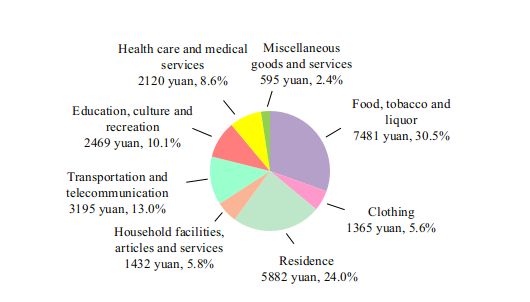
By the end of 2022, a total of 503.49 million people participated in basic endowment insurance program for urban workers, an increase of 22.75 million over that by the end of 2021. A total of 549.52 million people participated in basic endowment insurance program for urban and rural residents, an increase of 1.55 million. A total of 1,345.70 million people participated in basic medical insurance program[55]. Of this total, 362.42 million people participated in the program for workers, and 983.28 million people participated in the program for urban and rural residents. A total of 238.07 million people participated in unemployment insurance program, an increase of 8.49 million. The number of people receiving unemployment insurance payment stood at 2.97 million by the end of 2022. A total of 291.11 million people participated in work-related injury insurance, an increase of 8.25 million, of which 91.27 million were migrant workers, an increase of 410 thousand. A total of 246.08 million people participated in maternity insurance programs, an increase of 8.56 million. By the end of 2022, minimum living allowances were granted to 6.83 million urban residents and 33.49 million rural residents, 4.35 million rural residents living in extreme poverty[56] received relief and assistance and 10.83 million people received temporary assistance[57]. National pensions and subsidies were regularly provided to 8.27 million ex-servicemen and other entitled people in 2022.
By the end of 2022, there were altogether 43 thousand social welfare institutions providing accommodation, of which 40 thousand were elderly care institutions and 899 were institutions for child welfare, assistance and protection. The social welfare institutions provided 8.491 million beds[58], of which 8,223 thousand were for the elderly and 100 thousand were for children. By the end of 2022, there were 29 thousand community service centers and 509 thousand community service stations.
X. Science & Technology and Education
Expenditures on research and experimental development activities (R&D) were worth 3,087.0 billion yuan in 2022, up by 10.4 percent over that of 2021, accounting for 2.55 percent of GDP. Of this total, 195.1 billion yuan was used for basic research programs. A total of 51,900 projects were financed by the National Natural Science Foundation. By the end of 2022, there were altogether 533 state key laboratories in operation, 191 national engineering research centers under the new sequence management, 1,601 state-level enterprise technology centers and 212 demonstration centers for business startups and innovation. The National Fund for Technology Transfer and Commercialization established 36 sub-funds, with the total funds reaching 62.4 billion yuan. There were 1,425 state-level technology business incubators[59], and 2,441 national mass makerspaces[60]. A total of 4,323 thousand patents were authorized, down by 6.0 percent over that of the previous year. The number of PCT patent applications accepted[61] was 74 thousand. By the end of 2022, the number of valid patents was 17,879 thousand, of which 3,280 thousand were domestic valid invention patents. The number of high-value invention patents per 10,000 people[62] was 9.4. Trademark registration totaled 6,177 thousand, down by 20.2 percent over that of the previous year. A total of 770 thousand technology transfer contracts were signed, representing 4,779.1 billion yuan in value, up by 28.2 percent over that of the previous year. The proportion of citizens with scientific literacy[63] in China reached 12.93 percent.
Figure 20: Expenditure on Research and Experimental Development Activities (R&D) and Its Growth Rates 2018-2022
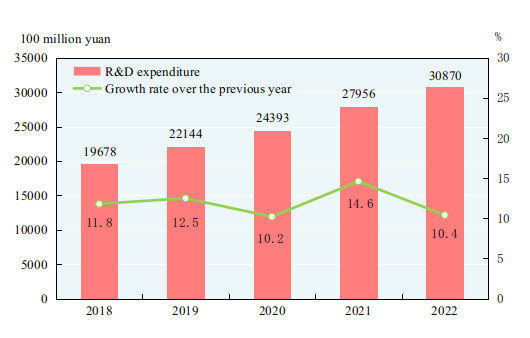
Table 16: Number of Patents Authorized and Valid Patents in 2022
|
Item |
Patents (10,000) |
Increase over 2021 (%) |
|
|
|
|
|
Number of patents authorized |
432.3 |
-6.0 |
|
Of which: domestic |
418.7 |
-5.9 |
|
Of which: for invention patents |
79.8 |
14.7 |
|
Of which: domestic |
68.9 |
19.2 |
|
Number of valid patents at the end of the year |
1787.9 |
15.9 |
|
Of which: domestic |
1671.9 |
17.0 |
|
Of which: for invention patents |
421.2 |
17.1 |
|
Of which: domestic |
328.0 |
21.3 |
|
|
|
|
The year 2022 saw a total of 62 successful space launches. Wentian and Mengtian lab modules were launched successfully, the missions of Shenzhou-14 and Shenzhou-15 were carried out, and China’s Space Station was fully completed. Chang’e 5 discovered the new lunar mineral “Chang’e stone”. The terrestrial ecosystem carbon monitoring satellite named “Goumang” and the atmospheric environment monitoring satellite were successfully sent into space. The Long March-8 rocket carrying 22 satellites blasted off. China’s third aircraft carrier “Fujian” was launched. The first C919 aircraft, China’s domestically-developed large jetliner, received its type certificate and was delivered. China’s Hualong one, a domestically designed third-generation nuclear reactor maintained safe and stable performance since it was put into commercial operation.
By the end of 2022, there were altogether 869 national quality inspection centers. There were 1,128 agencies for product quality and management system and service certification, accumulatively 940,000 enterprises were certified. A total of 2,266 national standards were developed or revised in the year, including 1,382 new standards. The qualification rate of manufactured products[64] reached 93.29 percent.
In 2022, graduate institutes enrolled 3.654 million students with 1.242 million new students and 0.862 million graduates. Total enrollment in undergraduate programs in regular and vocational higher education institutes[65] was 36.594 million students with 10.145 million new students and 9.673 million graduates. The enrollment in secondary vocational education[66] was 17.847 million, including 6.507 million new entrants, and 5.192 million graduates. Regular senior secondary schools had 27.139 million enrolled students, including 9.475 million new entrants, and 8.241 million graduates. Students enrolled in junior secondary schools totaled 51.206 million, including 17.314 million new entrants, and 16.239 million graduates. The country had a primary education enrollment of 107.320 million students, including 17.014 million new entrants, and 17.406 million graduates. There were 0.919 million students enrolled in special education schools, with 0.146 million new entrants and 0.159 million graduates. Kindergartens accommodated 46.275 million children. The number of students graduating from compulsory education reached 95.5 percent of the total enrollment, and the gross enrollment ratio for senior secondary education reached 91.6 percent.
Figure 21: Enrollment in Education 2018-2022
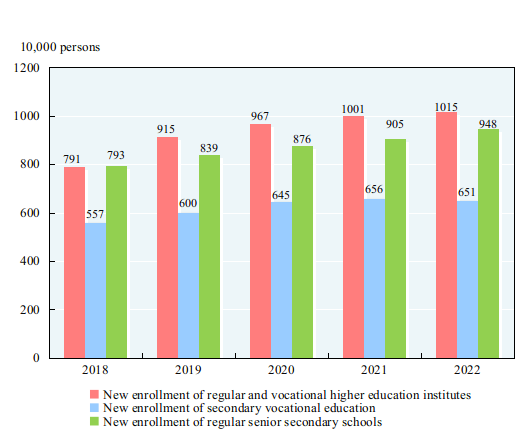
XI. Culture and Tourism, Public Health and Sports
By the end of 2022, there were 2,023 art-performing groups in the culture and tourism system throughout China. A total of 3,303 public libraries received[67] 723.75 million people. There were 3,503 cultural centers. Subscribers to cable television programs numbered 199 million, among which 190 million subscribed to digital cable television programs. By the end of 2022, radio broadcasting and television broadcasting coverage rates were 99.6 percent and 99.8 percent respectively. A total of 5,283 episodes of 160 TV series and 89,094 minutes of TV cartoons were made in 2022. The country produced 380 feature movies and 105 popular science movies, documentaries, animation and special movies[68]. A total of 26.6 billion copies of newspapers and 2.0 billion copies of magazines were issued, and 11.4 billion copies of books were published. The average number of books possessed per person[69] was 8.09 copies. By the end of the year, there were 4,136 archives in China and 208.86 million files were made accessible to the public. The business revenue of enterprises above the designated size engaged in culture and related industries reached 12,180.5 billion yuan, up by 0.9 percent over that of the previous year on a comparable basis.
The year 2022 registered 2.53 billion domestic tourists, down by 22.1 percent over that of the previous year. Of this total, there were 1.93 billion tourists from urban areas, a decrease of 17.7 percent; and 600 million tourists from rural areas, a decrease of 33.5 percent. Domestic tourism revenue was 2,044.4 billion yuan, down by 30.0 percent. Of this total, tourists from urban areas spent 1,688.1 billion yuan, down by 28.6 percent; and tourists from rural areas spent 356.3 billion yuan, down by 35.8 percent.
Figure 22: Person-times of Domestic Tourists and Its Growth Rates 2018-2022
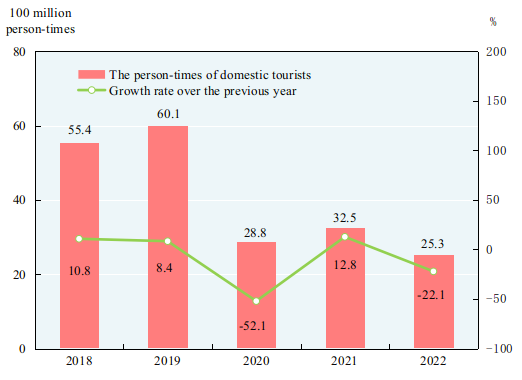
By the end of 2022, there were 1,033,000 medical and health institutions in China, including 37,000 hospitals. Of all the hospitals, 12,000 were public, and 25,000 were private. Of the 980,000 medical and health institutions at grass-root level, there were 34,000 town and township health centers, 36,000 community health service centers, 321,000 clinics and 588,000 village clinics. Of the 13,000 professional public health institutions, 3,385 were disease control and prevention centers and 2,796 were health monitoring institutions. By the end of 2022, there were 11.55 million medical technical personnel in China, including 4.40 million licensed doctors and licensed assistant doctors and 5.20 million registered nurses. The medical and health institutions in China possessed 9.75 million beds, of which hospitals possessed 7.66 million and township health centers had 1.45 million. The total number of medical visits[70] and hospital discharges[71] in 2022 reached 8.40 billion and 250 million respectively.
Figure 23: Year-end Number of Medical Technical Personnel 2018-2022
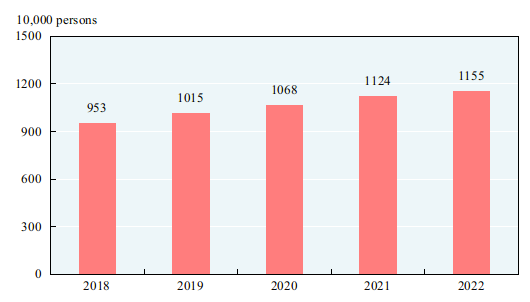
There were altogether 4.227 million sports venues[72]. The sports venue area[73] totaled 3.70 billion square meters and the per capita sports venue area was 2.62 square meters. In 2022, Chinese athletes won 93 world championships in 15 sports events and broke 11 world records. At the 24th Winter Olympic Games in Beijing, Chinese athletes won 9 gold medals and a total of 15 medals. Chinese physically-challenged athletes won 41 world championships in 5 international sports competitions. At the 13th Winter Paralympic Games in Beijing, Chinese athletes won 18 gold medals and a total of 61 medals, topping the gold medal tally and overall medal count.
XII. Resources, Environment and Emergency Management
In 2022, the total supply of state-owned land for construction use[74] was 766 thousand hectares, an increase of 10.9 percent over that of the previous year. Of this total, the land supply for industry, mining and warehousing was 198 thousand hectares, up by 13.2 percent; that for real estate[75] was 110 thousand hectares, down by 19.4 percent; and that for infrastructure facilities was 458 thousand hectares, up by 20.7 percent.
The total stock of water resources in 2022 was 2,663.4 billion cubic meters. With an increase of 1.3 percent over 2021, the total water consumption reached 599.7 billion cubic meters, of which water consumption for living purposes down by 0.5 percent, for industrial use down by 7.7 percent, for agricultural use up by 3.7 percent, and artificial recharge for environmental and ecological use grew by 8.3 percent. Water consumption per 10,000 yuan of GDP[76] was 53 cubic meters, a decline of 1.6 percent. Water consumption per 10,000 yuan of industrial value added was 27 cubic meters, down by 10.8 percent. The per capita water consumption was 425 cubic meters, up by 1.3 percent.
In 2022, the total area of afforestation reached 3.83 million hectares, of which 1.20 million hectares were afforested by manpower, accounting for 31.4 percent of the total. The land area improved by grass plantation[77] was 3.21 million hectares. By the end of 2022, there were 5 national parks. A total of 63 thousand square kilometers of land have been saved from soil erosion.
Preliminary estimation indicated that the total energy consumption in 2022 amounted to 5.41 billion tons of standard coal equivalent, up by 2.9 percent over that of 2021. The consumption of coal increased by 4.3 percent; crude oil, down by 3.1 percent; natural gas, down by 1.2 percent; and electric power, up by 3.6 percent. The consumption of coal accounted for 56.2 percent of the total energy consumption, 0.3 percentage point higher than that of 2021, while clean energy consumption, such as natural gas, hydropower, nuclear power, wind power and solar power accounted for 25.9 percent, 0.4 percentage point higher. The comprehensive energy consumption per unit calcium carbide by key energy-intensive industrial enterprises went down by 1.6 percent, per unit synthetic ammonia down by 0.8 percent, per ton steel up by 1.7 percent and per unit electrolytic aluminium down by 0.4 percent. The standard coal consumption per kilowatt-hour of thermal power generation decreased by 0.2 percent. The carbon dioxide emission per 10,000 yuan worth of GDP[78] was cut by 0.8 percent.
Figure 24: Proportion of Clean Energy Consumption in the Total Energy Consumption 2018-2022
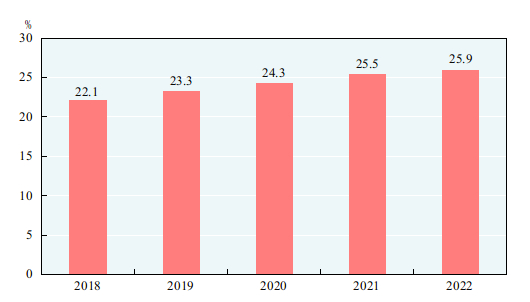
Area of offshore oceanic water[79] met the national quality standard Grade I and II accounted for 81.9 percent; that met Grade III standard 4.1 percent; and water of Grade IV or inferior quality 14.0 percent.
Of the 320 cities subject to urban regional daytime acoustic environment monitoring, 5.0 percent enjoyed excellent environment, 66.3 percent had good environment, 27.2 percent had average environment, 1.2 percent had relatively poor environment and 0.3 percent had poor environment in 2022.
The average temperature in 2022 was 10.51℃, down by 0.02℃ compared with that of the previous year. Typhoons hit China 4 times in 2022.
In 2022, natural disasters hit 12.07 million hectares of crops, of which 1.35 million hectares of crops were demolished. Flood, waterlogging and geological disasters caused a direct economic loss of 130.3 billion yuan. Droughts caused a direct economic loss of 51.3 billion yuan. Disasters caused by low temperature, frost and snow made a total direct economic loss of 12.5 billion yuan. Oceanic disasters caused a direct economic loss of 2.4 billion yuan. The country recorded 27 earthquakes with magnitude 5.0 and over, causing a direct economic loss about 22.4 billion yuan. The year 2022 witnessed 709 forest fires, with 5 thousand hectares of forests damaged.
The death toll due to work accidents amounted to 20,963 people in 2022. Work accidents in industrial, mining and commercial companies caused 1.097 deaths out of every 100 thousand employees, down by 20.2 percent over that of 2021. The death toll for one million tons of coal produced in coalmines was 0.054 people, up by 22.7 percent. The road traffic death toll per 10 thousand vehicles was 1.46 people, down by 7.0 percent.
Notes:
[1] All figures in this Communiqué are preliminary statistics. Statistics in this Communiqué do not include Hong Kong SAR, Macao SAR and Taiwan Province. Due to the rounding-off reasons, the subentries may not add up to the aggregate totals.
[2] Gross domestic product (GDP), value added of the three and related industries, regional GDP, per capita GDP and gross national income (GNI) as quoted in this Communiqué are calculated at current prices whereas their growth rates are at constant prices.
[3] Gross national income, also known as gross national product, refers to the total primary distribution of the income created by all the resident units of a country (or a region) during a certain period of time. It equals to gross domestic product plus the net primary distribution of income from abroad.
[4] The overall labor productivity refers to the ratio between the GDP (at 2020 constant prices) and the total number of persons employed.
[5] See note 4.
[6] The national population refers to the population of the 31 provinces, autonomous regions and municipalities directly under the central government and servicemen of the Chinese mainland, excluding residents of Hong Kong, Macao and Taiwan and foreigners living in the 31 provinces, autonomous regions and municipalities directly under the central government.
[7] By the end of 2022, the population aged 0 to 14 (under the age of 15) was 239.08 million and that aged 15 to 59 (under the age of 60) was 892.63 million.
[8] The number of migrant workers includes those who are employed outside their villages and towns for more than six months in the year and those who are engaged in non-agricultural work in their villages and towns for more than six months in the year.
[9] The producer prices for farm products refer to the prices of farm products sold directly by producers.
[10] The prices for residence include prices for rent, maintenance and management, water, electricity and fuel, and services for owner-occupied housing etc.
[11] High technology manufacturing industry includes manufacture of medicine, manufacture of aerospace vehicle and equipment, manufacture of electronic and communication equipment, manufacture of computers and office equipment, manufacture of medical equipment, manufacture of measuring instrument and equipment and manufacture of optical and photographic equipment.
[12] Manufacture of equipment includes manufacture of metal products, general purpose equipment, special purpose equipment, automobiles, railway, ship, aerospace and other transport equipment, electrical machinery and apparatus, computers, communication and other electric equipment and measuring instrument and machinery.
[13] Service enterprises above the designated size refer to legal entities of transport, storage and post, information transmission, software and information technology services, water conservancy, environment and public facilities management, and health with annual business revenue of 20 million yuan and above; legal entities of real estate (excluding real estate development and operation), leasing and business services, scientific research and technology services and education with annual business revenue of 10 million yuan and above; and legal entities of services to households, repair and other services and culture, sports and entertainment, and social services with annual business revenue of 5 million and above.
[14] Strategic emerging service industries refer to the related service sectors of information technology of new generation, manufacture of high-end equipment, new materials, biotech, new energy vehicles, new energy, energy-saving and environmental protection and digital creative industries, and service industries related to new technology, innovation and entrepreneurship. The growth rate of the business revenue of the strategic emerging service industries in 2022 was calculated on a comparable basis.
[15] Investment in high technology industries refers to investment in six high technology manufacturing industries, including the manufacture of medicine and manufacture of aerospace vehicle and equipment, and nine high technology service industries, including information service and e-commerce service.
[16] E-commerce transactions refer to the transactions of goods and services realized through e-commerce trading platforms (including self-built and third-party platforms), including transactions with entities and individuals.
[17] Online retail sales refer to the retail sales of goods and services realized through internet trading platforms (online platforms mainly in trading physical commodities, including self-built websites and third-party platforms).
[18] The eastern areas include 10 provinces and municipalities: Beijing, Tianjin, Hebei, Shanghai, Jiangsu, Zhejiang, Fujian, Shandong, Guangdong and Hainan; the central areas cover 6 provinces: Shanxi, Anhui, Jiangxi, Henan, Hubei and Hunan; the western areas include 12 provinces, autonomous regions and municipalities: Inner Mongolia, Guangxi, Chongqing, Sichuan, Guizhou, Yunnan, Tibet, Shaanxi, Gansu, Qinghai, Ningxia and Xinjiang; the northeastern areas include 3 provinces: Liaoning, Jilin and Heilongjiang.
[19] The energy consumption per 10,000 yuan worth of GDP is calculated at 2020 constant prices.
[20] Output data of some products were verified and adjusted in 2021; the growth rates of output in 2022 were calculated on a comparable basis.
[21] Thermal power refers to electricity generated by coal, oil, gas, residual heat, pressure and gas, waste incineration and biomass.
[22] The data included the steel reprocessed among enterprises.
[23] A few installed power generation capacity (e.g. geothermal) is not listed.
[24] The growth rates and rate changes of financial indicators of industrial enterprises above the designated size in 2022 were calculated on a comparable basis due to adjustments of data coverage in the statistical programmes, statistical law enforcement and removal of duplicated data.
[25] Capacity utilization rate refers to the ratio of the actual production to the production capacity (in terms of value). Actual production refers to the total industrial output value during the enterprise’s reporting period. Production capacity refers to the production which can be realized and sustained for a long term under the condition of the supply of labor force, materials, fuel and transportation guaranteed and the production equipment in proper operation.
[26] The total freight traffic and flows include the traffic and flows by railways, highways, waterways, civil aviation and pipelines and the growth rates in 2022 were calculated on a comparable basis.
[27] The turnover of post services was calculated at the constant prices of 2020.
[28] The turnover of telecommunication services was calculated based on the prices of the previous year.
[29] The number of mobile phone base stations refers to the total number of wireless transceivers serving communities that handle the wireless communication between the base stations and mobile stations, relay between the mobile switchboards and mobile stations, and monitor the quality of wireless transmission at the end of the reporting period.
[30] Fixed broadband internet users refer to those who subscribed to the telecommunication enterprises and access the Internet through xDSL, FTTx+LAN, FTTH/0 and other broadband access ways as well as general dedicated lines at the end of the reporting period.
[31] Users of broadband with the speed of 100M and above refer to those who enjoy a downstream rate of 100Mbit/s or above at the end of the reporting period.
[32] Users of cellular internet of things terminals refer to those who access the mobile internet and subscribe to the internet of things services at the end of the reporting period. Internet of things terminals refers to the internet of things devices that connect the sensing network layer and the transmission network layer to implement remote data collection and data transmission to the network layer.
[33] The number of mobile internet surfers refers to the number of people who have accessed the internet through mobile phones over the past half year.
[34] Software and information technology services industry includes software development, integrated circuit design, information system integration and internet of things technology services, operation maintenance services, information processing and storage support services, IT consulting services, digital content services and other IT services industry.
[35] See Note 18.
[36] Private investment in fixed assets refers to investment in the construction or purchase of fixed assets by domestic collective, private and individual-owned enterprises and institutions or their holding enterprises (including absolute holding and relative holding enterprises).
[37] Investment in infrastructure includes investment in railway transportation, highway transportation, waterway transportation, civil aviation transportation, pipeline transportation, multi-modal transportation and forwarding agency, loading, unloading and delivery, postal service, telecommunication, radio, TV and satellite transmission, internet and related services, management of water conservancy, ecological conservation and environmental governance, and management of public facilities.
[38] Investment in social sector includes investment in education, health and social services, culture, sports and recreation.
[39] The investment in real estate includes the investment in real estate development, construction of buildings for own use, property management, intermediary services and other real estate investment.
[40] The Belt and Road refers to the Silk Road Economic Belt and the 21st Century Maritime Silk Road.
[41] Other Regional Comprehensive Economic Partnership (RCEP) member countries include Indonesia, Malaysia, Philippines, Thailand, Singapore, Brunei, Cambodia, Laos, Myanmar, Vietnam, Japan, Republic of Korea, Australia and New Zealand.
[42] The statistical survey program of foreign investment was revised in 2022. The newly-established enterprises with foreign direct investment and the foreign direct investment actually utilized are full caliber data covering banking, securities and insurance and the growth rate was calculated on a comparable basis.
[43] The AFRE (flow) refers to the total volume of financing provided by the financial system to the real economy within a certain period of time.
[44] The AFRE (stock) refers to the outstanding financing provided by the financial system to the real economy at the end of a period of time (a month, a quarter or a year).
[45] Inclusive finance loans include loans to micro and small businesses with single-client credit line under 10 million yuan, operating loans to self-employed businesses and owners of micro and small businesses, producing and operating loans to farmers, consumption loans to registered people living in poverty, venture guarantee loans and student loans.
[46] Funds raised through Shanghai and Shenzhen Stock Exchanges are calculated by the money raised on the listing date, and the funds raised include the actual exchanged convertible bonds, which were 134.2 billion yuan in 2021 and 93.4 billion yuan in 2022.
[47] Funds raised through Beijing Stock Exchanges are calculated by the money raised on the listing date.
[48] National Equities Exchange and Quotations is a national securities exchange established upon approval by the State Council in 2012. Preferred stocks were excluded from funds raised by listed companies in National Equities Exchange and Quotations. Funds raised by shares are calculated by the disclosure date of the issuance report.
[49] Corporate credit bonds include debt financing instruments issued by non-financial businesses, enterprise bonds, corporate bonds and convertible bonds.
[50] The premium of primary insurance received by the insurance companies refers to the premium income from primary insurance contracts confirmed by the insurance companies.
[51] The median of per capita disposable income refers to the per capita income of household lied in the middle of all surveyed households which are ranked from low to high (or high to low) based on per capita disposable income level.
[52] The income quintile refers to the five equal partitions of all surveyed households, who are ranked from low to high based on per capita income level. The top 20 percent with the highest income are classified as high-income group, and the other four levels are upper-middle-income group, middle-income group, lower-middle-income group and low-income group.
[53] Counties lifted out of poverty include 832 key counties under the national poverty alleviation and development program and counties in contiguous poor areas as well as 7 cities and counties in Aksu prefecture, Xinjiang.
[54] The consumption expenditure on services refers to the spending by households on services for daily lives including catering, clothing and footwear processing, housing, family, transportation and telecommunication, education, culture and recreation, medical services and others.
[55] In 2022, the statistical coverage for participants in basic medical insurance program has been changed with some repetitive participation removed.
[56] Rural residents living in extreme poverty refer to the aged, the disabled and the minor under 16 years of age in rural areas who have no ability to work, no sources of income and no statutory obligors to provide for them, bring them up or support them, or whose statutory obligors have no ability to fulfill their obligations.
[57] Temporary assistance refers to emergent and transitional assistance the government provides to families or individuals who experience hardships because of emergencies, unexpected harm, major diseases or other unusual factors and are not covered by other forms of social assistance programs or still suffer hardships after receiving other social assistance programs.
[58] The beds provided by social welfare institutions include beds provided by adoption agencies, aid agencies and community agencies.
[59] The state-level technology business incubators are technology-based business startup service providers consistent with the Administrative Measures for Technology Business Incubators that provide physical space, shared facilities and professional services with the mission of advancing transformation of technological achievements, cultivating technological enterprises and fostering the entrepreneurial spirit. They should be approved and accredited by the Ministry of Science and Technology.
[60] The national mass makerspaces are new service platform for entrepreneurship and innovation that are in conformity with the Guidelines on Developing Mass Makerspaces and are reviewed and registered by the Ministry of Science and Technology in accordance with the Provisional Registration Regulations on National Mass Makerspaces.
[61] The number of PCT patent applications accepted refers to the number of PCT patent application accepted by the State Intellectual Property Office which acts as the receiving office of PCT patent application. PCT is the abbreviation of Patent Cooperation Treaty, which is a treaty for international cooperation in the field of patents.
[62] The number of high-value invention patents per 10,000 people refers to the number of valid invention patents owned per 10,000 national residents which are authorized by the China National Intellectual Property Administration and satisfy any of the following conditions: invention patents for strategic emerging industries; invention patents having corresponding foreign patents; invention patents maintained more than 10 years; invention patents with a relatively high pledge financing amount; and invention patents that won the National Science and Technology Award and the China Patent Award.
[63] Citizens with scientific literacy refers to citizens carrying out scientific spirit, spreading scientific philosophy, mastering basic scientific methods and scientific knowledge, and able to apply them to analysis and problem solving. The proportion of citizens with scientific literacy was obtained from the sample survey for citizens aged from 18 to 69.
[64] The qualification rate of manufactured products is the ratio of the samples that have passed the sampling quality test, the process of which follows certain methods, procedure and standard, to the total amount of the sampled products. The survey samples cover 29 sectors of the manufacturing industry.
[65] Regular and vocational higher education institutes include regular universities, vocational undergraduate education and higher vocational colleges.
[66] Secondary vocational education includes regular specialized secondary schools, adult specialized secondary schools, vocational high schools and skilled workers schools.
[67] The people received by the public libraries refer to the number of people who visit libraries and use library services in the year, including borrowing and reading books, consultation and attending readers’ programs.
[68] Special movies refer to those using different display modes in terms of projection techniques, equipment and program as compared with the ordinary cinemas, such as IMAX movies, 3D movies, 4D movies, multidimensional movies and full dome movies.
[69] The average number of books possessed per person refers to the average number of books published in the year that can be possessed per person in China.
[70] The total number of medical visits refers to the number of people receiving medical services, including outpatient services, emergency treatment, home visits, appointment-based diagnosis and treatment, health check-up of a specific item, and health consultation and guidance (excluding health lectures and nucleic acid tests).
[71] The number of hospital discharges refers to the number of inpatients discharged from hospitals in the reporting period, including those who are discharged from hospitals or transferred to other medical institutions following doctors’ advice, discharged from hospitals without doctors’ permission, dead or other situations. The number of people who are recovered from family sickbeds is excluded.
[72] The sports venues belonging to armed forces and railway system are excluded in the census on sports venues.
[73] The sports venue area refers to area used for physical training, sports competitions and physical fitness.
[74] Total supply of state-owned land for construction use refers to the total amount of state-owned land for construction use with the land-use right transferred, allocated or leased to units or individuals through signed transaction contracts and allocation decisions by the municipal or county governments according to annual land supply plan and in line with relevant laws in the reporting period.
[75] Land used for real estate refers to the sum of land used for commercial service and for residence.
[76] The water consumption per 10,000 yuan of GDP and water consumption per 10,000 yuan of industrial value added are calculated at prices of 2020.
[77] The land area improved by grass plantation refers to the area of increased forage grass by adopting measures such as sowing and cultivation plus the area where primitive vegetation and the ecology of grasslands have been improved by measures such as restraining the content of salt, alkali and sand, improving the quality of soil and fencing the forests.
[78] The carbon dioxide emission per 10,000 yuan worth of GDP is calculated at prices of 2020.
[79] Offshore oceanic water quality is evaluated by the area method.
Data Sources:
In this Communiqué, data of newly increased employed people in urban areas, endowment insurance, unemployment insurance, work injury insurance and skilled workers schools are from the Ministry of Human Resources and Social Security; data of foreign exchange reserves and exchange rates are from the State Administration of Foreign Exchange; data of market entities, quality inspection, the formulation and revision of national standards and qualification rate of manufactured products are from the State Administration for Market Regulation; data of environment monitoring are from the Ministry of Ecology and Environment; data of output of aquatic products and area of farmland newly equipped with water-saving irrigation systems are from the Ministry of Agriculture and Rural Affairs; data of production of timber, area of afforestation, area of grass planting and improvement and national parks are from the National Forestry and Grassland Administration; data of area of farmland newly equipped with irrigation system, water resources, water consumption and land newly saved from soil erosion are from the Ministry of Water Resources; data of installed power generation capacity, newly increased power transformer equipment with a capacity of over 220 kilovolts and electricity consumption are from the China Electricity Council; data of volume of freight handled by ports, container shipping of ports, highway transportation, waterway transportation, new and rebuilt highways and new throughput capacity of berths for over 10,000-tonnage ships are from the Ministry of Transport; data of railway transportation, new railways put into operation, new double-track railways put into operation and electrified railways put into operation are from China Railway; data of civil aviation and new civil transportation airports are from the Civil Aviation Administration of China; data of pipeline transportation are from China National Petroleum Corporation, China Petrochemical Corporation, China National Offshore Oil Corporation and China Oil & Gas Piping Network Corporation; data of motor vehicles for civilian use and traffic accidents are from the Ministry of Public Security; data of postal service are from the State Post Bureau; data of telecommunication, software revenue, and new lines of optical-fiber cables are from the Ministry of Industry and Information Technology; data of internet users and internet coverage are from the China Internet Network Information Center; data of housing units rebuilt in rundown urban areas, government-subsidized rental housing and renovation of old urban residential communities are from the Ministry of Housing and Urban-Rural Development; data of imports and exports of goods are from the General Administration of Customs; data of imports and exports of services, foreign direct investment, outbound direct investment, overseas contracted projects and overseas labor contracts are from the Ministry of Commerce; data of finance are from the Ministry of Finance; data of newly added tax and fee cuts, deferrals and tax refunds are from the State Taxation Administration; data of monetary finance and corporate credit bonds are from the People’s Bank of China; data of funds raised through domestic exchange markets are from China Securities Regulatory Commission; data of the insurance sector are from China Banking and Insurance Regulatory Commission; data of medical insurance and maternity insurance are from the National Healthcare and Security Administration; data of urban and rural minimum living allowances, relief and assistance granted to rural residents living in extreme poverty, temporary assistance and social welfare are from the Ministry of Civil Affairs; data of entitled people are from the Ministry of Veterans Affairs; data of natural science foundation projects are from the National Natural Science Foundation; data of state key laboratories, National Fund for Technology Transfer and Commercialization, state-level technology business incubators, national mass makerspaces and technology transfer contracts are from the Ministry of Science and Technology; data of national engineering research centers, enterprise technical centers and demonstration centers for business startups and innovation are from the National Development and Reform Commission; data of patents and trademarks are from the National Intellectual Property Administration; data of the proportion of citizens with scientific literacy are from the China Association for Science and Technology; data of satellite launches are from the State Administration of Science, Technology and Industry for National Defense; data of education are from the Ministry of Education; data of art-performing groups, public libraries, cultural centers and tourism are from the Ministry of Culture and Tourism; data of television and radio programs are from the National Radio and Television Administration; data of movies are from the China Film Administration; data of newspapers, magazines and books are from the National Press and Publication Administration; data of files are from the State Archives Administration; data of medical care and health are from the National Health Commission; data of sports are from the General Administration of Sport; data of physically-challenged athletes are from the China Disabled Persons’ Federation; data of supply of state-owned land for construction use and direct economic loss caused by oceanic disasters are from the Ministry of Natural Resources; data of average temperature and typhoons are from the China Meteorological Administration; data of areas of crops hit by natural disasters, direct economic loss caused by flood, waterlogging and geological disasters, direct economic loss caused by droughts, direct economic loss caused by low temperature, frost and snow, the number of earthquakes, direct economic loss caused by earthquakes, forest fires, areas of forests damaged and workplace accidents are from the Ministry of Emergency Management; all the other data are from the National Bureau of Statistics.
In case of any differences between English translation and the original Chinese text, the Chinese edition shall prevail.
